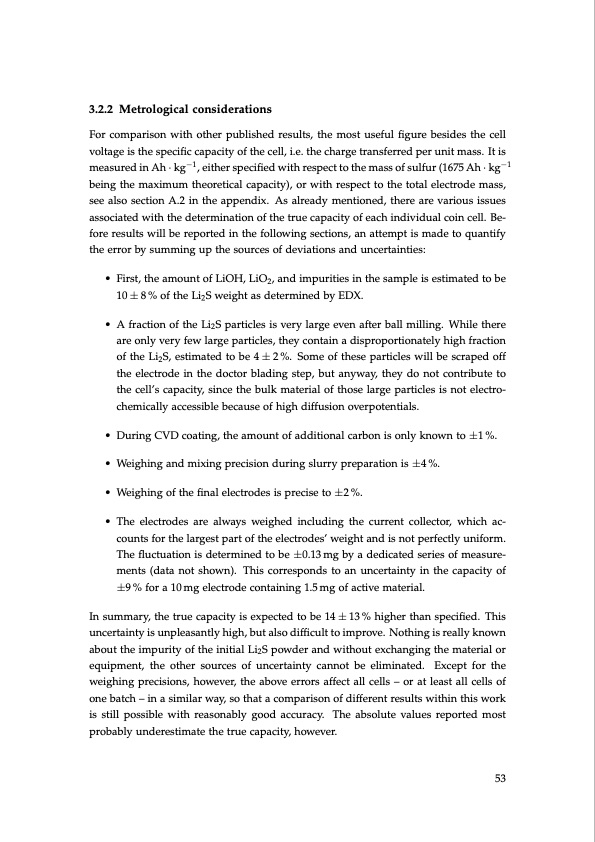
PDF Publication Title:
Text from PDF Page: 053
3.2.2 Metrological considerations For comparison with other published results, the most useful figure besides the cell voltage is the specific capacity of the cell, i.e. the charge transferred per unit mass. It is measured in Ah · kg−1, either specified with respect to the mass of sulfur (1675 Ah · kg−1 being the maximum theoretical capacity), or with respect to the total electrode mass, see also section A.2 in the appendix. As already mentioned, there are various issues associated with the determination of the true capacity of each individual coin cell. Be- fore results will be reported in the following sections, an attempt is made to quantify the error by summing up the sources of deviations and uncertainties: • First, the amount of LiOH, LiO2, and impurities in the sample is estimated to be 10 ± 8 % of the Li2S weight as determined by EDX. • A fraction of the Li2S particles is very large even after ball milling. While there are only very few large particles, they contain a disproportionately high fraction of the Li2S, estimated to be 4 ± 2 %. Some of these particles will be scraped off the electrode in the doctor blading step, but anyway, they do not contribute to the cell’s capacity, since the bulk material of those large particles is not electro- chemically accessible because of high diffusion overpotentials. • During CVD coating, the amount of additional carbon is only known to ±1 %. • Weighing and mixing precision during slurry preparation is ±4 %. • Weighing of the final electrodes is precise to ±2 %. • The electrodes are always weighed including the current collector, which ac- counts for the largest part of the electrodes’ weight and is not perfectly uniform. The fluctuation is determined to be ±0.13 mg by a dedicated series of measure- ments (data not shown). This corresponds to an uncertainty in the capacity of ±9 % for a 10 mg electrode containing 1.5 mg of active material. In summary, the true capacity is expected to be 14 ± 13 % higher than specified. This uncertainty is unpleasantly high, but also difficult to improve. Nothing is really known about the impurity of the initial Li2S powder and without exchanging the material or equipment, the other sources of uncertainty cannot be eliminated. Except for the weighing precisions, however, the above errors affect all cells – or at least all cells of one batch – in a similar way, so that a comparison of different results within this work is still possible with reasonably good accuracy. The absolute values reported most probably underestimate the true capacity, however. 53PDF Image | Lithium-Sulfur Battery: Design, Characterization, and Physically-based Modeling

PDF Search Title:
Lithium-Sulfur Battery: Design, Characterization, and Physically-based ModelingOriginal File Name Searched:
Dissertation_David_N._Fronczek_The_Lithium_Sulfur_Battery.pdfDIY PDF Search: Google It | Yahoo | Bing
Sulfur Deposition on Carbon Nanofibers using Supercritical CO2 Sulfur Deposition on Carbon Nanofibers using Supercritical CO2. Gamma sulfur also known as mother of pearl sulfur and nacreous sulfur... More Info
CO2 Organic Rankine Cycle Experimenter Platform The supercritical CO2 phase change system is both a heat pump and organic rankine cycle which can be used for those purposes and as a supercritical extractor for advanced subcritical and supercritical extraction technology. Uses include producing nanoparticles, precious metal CO2 extraction, lithium battery recycling, and other applications... More Info
| CONTACT TEL: 608-238-6001 Email: greg@infinityturbine.com | RSS | AMP |